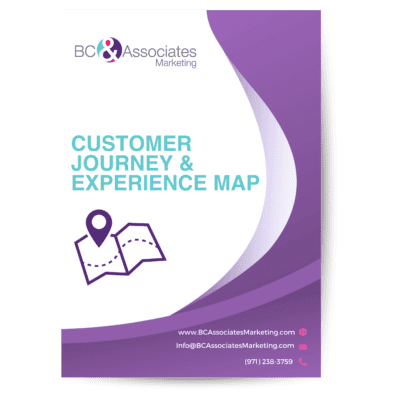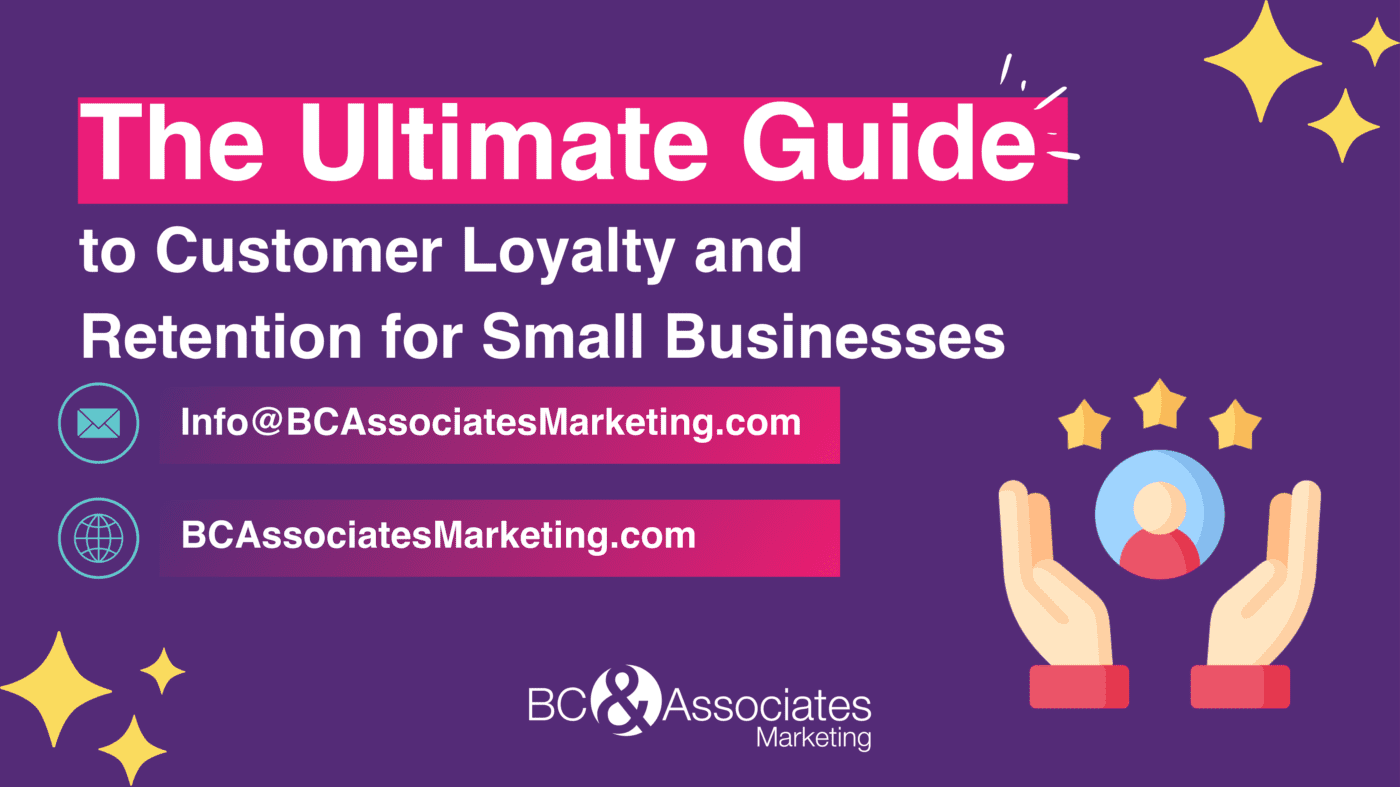Customer loyalty is the lifeblood of any small business. It’s not just about attracting new customers but also about retaining existing ones and fostering long-term relationships. This comprehensive guide will explore the importance of customer loyalty and retention for small businesses, discuss best practices to enhance customer satisfaction and loyalty and highlight common mistakes to avoid. Whether you’re a startup or an established business, implementing effective loyalty strategies can drive growth, increase revenue, and create brand advocates who champion your business.
Who Is Your Customer?
Understanding your target market and creating detailed customer personas are fundamental to developing an effective marketing strategy. Identifying your target market involves more than making assumptions based on intuition or personal preferences. To accurately determine your target market, you need to conduct thorough research and gather data that provides insights into the demographics, preferences, behaviors, and needs of potential customers. Here are some steps to help you find out who your target market actually is:
- Market Research: Start by conducting market research to gather information about your industry, competitors, and target audience. Use tools like surveys, focus groups, and interviews to collect data directly from potential customers. Analyze market trends, consumer behavior, and purchasing patterns to identify opportunities and gaps in the market.
- Customer Profiling: Create detailed customer profiles or buyer personas representing your ideal customers. Consider age, gender, location, income level, occupation, interests, and values. Develop personas based on real data and insights rather than assumptions to ensure accuracy.
- Analyze Existing Customers: Examine your existing customer base to identify common characteristics and preferences among your most loyal and profitable customers. Look for trends and patterns in their demographics, purchasing behavior, and interactions with your brand.
- Use Analytics Tools: Utilize analytics tools such as Google Analytics, social media insights, and customer relationship management (CRM) software to gather data about your website visitors, social media followers, and email subscribers—track metrics like demographics, engagement levels, and conversion rates to understand who interacts with your brand.
- Conduct Surveys and Feedback: Regularly solicit customer feedback through surveys, reviews, and feedback forms. Ask about their preferences, pain points, and reasons for choosing your products or services. Use this information to refine your target market segmentation and tailor your offerings to meet their needs better.
- Monitor Competitors: Monitor your competitors and analyze their target market strategies. Look at who they are targeting, positioning their products or services, and what marketing channels they use to reach their audience. Identify areas where you can differentiate yourself and appeal to a niche market segment.
By following these steps and leveraging various research methods and tools, you can gain a deeper understanding of your target market and develop more effective marketing strategies to reach and engage with them.
Why You Want To Understand Your Target Market
1. Tailored Messaging: By identifying your target audience and creating customer personas, you gain insights into their demographics, preferences, pain points, and purchasing behavior. This information enables you to craft personalized and targeted marketing messages that resonate with your audience, increasing the likelihood of engagement and conversion.
2. Enhanced Product Development: Understanding your target market allows you to tailor your products or services to meet their needs and preferences. By identifying gaps in the market or areas where competitors are falling short, you can develop offerings that address customer pain points and differentiate your brand from the competition.
3. Improved Customer Experience: Customer personas help you anticipate your audience’s expectations and deliver a seamless and personalized experience across all touchpoints. By understanding their motivations and behaviors, you can optimize your website, customer service interactions, and marketing campaigns to meet their needs better and exceed their expectations.
4. Efficient Resource Allocation: By focusing your marketing efforts on your target audience, you can allocate your resources more efficiently and effectively. Rather than casting a wide net and hoping to attract customers, you can invest your time, energy, and budget into channels and tactics most likely to reach and resonate with your ideal customers.
5. Competitive Advantage: A deep understanding of your target market gives you a competitive edge by enabling you to identify emerging trends, anticipate changes in consumer behavior, and stay ahead of the competition. By continuously refining your customer personas based on feedback and market research, you can adapt your marketing strategy to evolving customer needs and preferences, maintaining relevance and driving long-term success.
What Problems Do You Solve?
Focusing on how you solve your customer’s problems, understanding their fears, and addressing their frustrations is paramount to crafting effective messaging and marketing strategies. Customers are more likely to engage with a brand that clearly understands their needs and offers solutions that resonate with them.
By empathizing with your customers’ challenges, you can tailor your messaging to address their pain points directly, making your brand more relevant and compelling. Research conducted by Salesforce found that 84% of customers say being treated like a person, not a number, is crucial to winning their business. This highlights the significance of humanizing your brand and empathizing with your customers’ concerns.
Moreover, understanding your customers’ fears and frustrations allows you to anticipate potential obstacles in their journey and proactively provide solutions to alleviate them. By positioning your product or service as the answer to their problems, you can instill confidence and trust in your brand, ultimately driving conversion and loyalty.
To effectively communicate how you solve your customers’ problems, it is essential to listen actively to their feedback, conduct thorough market research, and leverage customer insights to inform your messaging strategy. By speaking directly to your customer’s pain points and offering tangible solutions, you can create messaging that resonates deeply with your target audience and sets your brand apart from competitors.
Customer Experience Matters
Mapping the customer journey is essential for creating the best customer experience and increasing retention and loyalty. Customer experience encompasses a customer’s entire journey with a brand, from initial awareness to post-purchase interactions. In contrast, customer service refers explicitly to a single interaction of customer support and assistance when they have questions, concerns, or issues. Here’s why it’s so important:
1. Understanding Customer Needs: By mapping out the customer journey, businesses gain a comprehensive understanding of their customers’ needs, preferences, and pain points at each stage of the buying process. This insight allows them to tailor their products, services, and marketing efforts to meet customer expectations better and address their specific challenges.
2. Identifying Touchpoints: Mapping out the customer journey helps businesses identify all the touchpoints where customers interact with their brand, both online and offline. This includes everything from initial awareness through post-purchase support. By understanding these touchpoints, businesses can ensure a consistent and cohesive experience across all channels, essential for building trust and loyalty.
3. Improving Communication: A well-defined customer journey enables businesses to communicate with customers more effectively at each stage of their buying journey. Businesses can enhance engagement, nurture leads, and drive conversions by delivering the right message to the right person at the right time. This personalized communication approach helps build stronger customer relationships and fosters loyalty over time.
4. Enhancing Customer Experience: Mapping out the customer journey allows businesses to identify areas where the customer experience can be improved. Businesses can create a more seamless and enjoyable customer experience by optimizing key touchpoints and removing friction from the buying process. This not only increases satisfaction but also encourages repeat purchases and word-of-mouth referrals.
5. Increasing Retention and Loyalty: A positive customer experience is closely linked to customer retention and loyalty. By mapping out the customer journey and ensuring a consistent and exceptional experience at every stage, businesses can increase customer satisfaction, encourage repeat business, and foster long-term loyalty. Satisfied customers are likelier to become brand advocates, recommending the business to others and contributing to its growth and success.
In summary, mapping out the customer journey is critical for creating a customer-centric business approach that prioritizes the customer’s needs and preferences. By understanding the customer journey, businesses can deliver personalized experiences, build stronger relationships, and ultimately drive long-term success and growth.
Your Competitive Advantage
Focusing on customer experience can be a significant differentiator from your competitors, yet many businesses fail to prioritize it. According to a report by PwC, 32% of customers say they would stop doing business with a brand they loved after just one bad experience. This highlights the critical role that customer experience plays in retaining customers and fostering loyalty.
Furthermore, research by Temkin Group found that companies that excel at customer experience have a 16% advantage in customer satisfaction over their competitors. This demonstrates that investing in customer experience improves satisfaction levels and gives businesses a competitive edge.
Despite these benefits, many businesses still struggle to deliver exceptional customer experiences. In fact, a study by Bain & Company revealed that while 80% of companies believe they deliver superior customer service, only 8% of customers agree. This stark disconnect underscores the importance of prioritizing customer experience and ensuring it meets or exceeds customer expectations.
By focusing on customer experience as a true differentiator, businesses can set themselves apart from competitors and build stronger customer relationships. This involves understanding customer needs and preferences, delivering personalized interactions, and continuously seeking feedback to improve and innovate. Ultimately, businesses prioritizing customer experience are better positioned to succeed in today’s competitive landscape and drive long-term growth.
Why Customer Loyalty Matters:
Customer loyalty is not just a nice-to-have for small businesses; it’s essential for sustainable growth and long-term success. Acquiring new customers is undoubtedly important for business growth, but retaining existing customers can be even more valuable in the long run. According to research by Bain & Company, increasing customer retention rates by just 5% can lead to a profit increase of 25% to 95%. This is because the cost of acquiring new customers is significantly higher than retaining existing ones. In fact, acquiring a new customer can cost up to five times more than retaining an existing one, as reported by Harvard Business Review.
Additionally, loyal customers tend to spend more over time. According to the White House Office of Consumer Affairs, loyal customers are worth up to 10 times as much as their first purchase. Therefore, investing in strategies to retain and nurture existing customers can lead to substantial long-term value and sustainable business growth. Here is why customer loyalty Is a game changer:
1. Revenue Growth: Research by Bain & Company indicates that even a modest increase in customer retention rates can significantly impact profitability. By boosting customer retention by just 5%, businesses can increase profits from 25% to 95%. This is because loyal customers are more likely to make repeat purchases and spend more over their lifetime with your business.
2. Cost Savings: Acquiring new customers can be expensive for small businesses. In fact, according to the Harvard Business Review, acquiring a new customer can cost up to five times more than retaining an existing one. By focusing on customer retention, businesses can reduce their acquisition costs and allocate resources more efficiently, ultimately improving their bottom line.
3. Brand Advocacy: Loyal customers contribute to revenue growth and act as brand ambassadors for your business. Customers who are satisfied with their experiences are more likely to recommend your products or services to friends, family, and colleagues. These word-of-mouth referrals are incredibly valuable as they carry trust and credibility that traditional advertising cannot replicate. By nurturing customer loyalty, small businesses can leverage the power of brand advocacy to drive organic growth and expand their customer base.
Raving Fans Are The Goal
Creating raving fans is the pinnacle of customer loyalty and can significantly contribute to building trust and authority for your business. These enthusiastic supporters continue to purchase from you and actively promote your brand to others, becoming invaluable advocates. Raving fans believe in your products or services and resonate with your brand values and mission, fostering a deeper emotional connection. Their advocacy and positive word-of-mouth can enhance your credibility and authority within your industry and community.
- To cultivate raving fans, it’s crucial to prioritize delivering exceptional customer experiences at every stage of their journey with your business. This means going beyond merely meeting their expectations and striving to exceed them consistently. Whether it’s their first interaction with your brand or a repeat purchase, each touchpoint should leave a lasting positive impression.
- One way to achieve this is by personalizing interactions to cater to your customer’s unique needs and preferences. Understanding their preferences, purchase history, and pain points allows you to tailor your communications and offerings to resonate with them more deeply. This might involve emailing them by name, recommending products or services based on past purchases, or providing customized solutions to their challenges.
- Promptly addressing their needs and concerns is another essential aspect of creating exceptional experiences. Whether responding to timely inquiries, resolving issues efficiently, or providing support whenever they need it, showing that you value their time and satisfaction builds trust and loyalty.
- Encouraging customer feedback is also key to fostering a culture of continuous improvement. Actively soliciting their input and listening to their suggestions demonstrates that you value their opinion and provides valuable insights into areas where you can enhance your products, services, or overall customer experience. This proactive approach to feedback strengthens your relationship with existing customers and helps attract new ones by showcasing your commitment to delivering excellence.
- Cultivating raving fans requires exceptional service, personalized attention, and a genuine commitment to customer satisfaction. By consistently exceeding expectations, promptly addressing their needs, and actively seeking feedback, you can turn satisfied customers into passionate advocates who trust your brand and promote it to others.
Moreover, it creates opportunities for engagement and community-building, such as exclusive events, loyalty programs, or online forums, where fans can connect and share their experiences. By nurturing relationships and fostering a sense of belonging, you can turn satisfied customers into passionate advocates who trust and actively champion your brand, strengthening your authority and influence in the marketplace.
Best Practices for Building Customer Loyalty:
Building customer loyalty requires a thoughtful approach and consistent effort. Here are some best practices to consider:
1. Personalized Customer Experience: Get to know your customers and tailor your products, services, and communications to meet their needs and preferences. Use data and analytics to segment your audience and deliver targeted messaging that resonates with each customer segment.
2. Consistent Communication: Stay in touch with your customers through regular email newsletters, social media updates, and personalized messages. Keep your brand in mind by sharing relevant content, promotions, and updates about your products or services.
3. Reward Programs: Implement loyalty programs, discounts, or rewards programs to incentivize repeat purchases and encourage customer loyalty. Offer exclusive perks, discounts, or freebies to customers who regularly engage with your brand or make repeat purchases.
4. Exceptional Customer Service: Provide exceptional customer service at every touchpoint. Be responsive to inquiries, resolve issues promptly, and go above and beyond to exceed customer expectations. A positive customer service experience can turn a satisfied customer into a loyal advocate for your brand.
5. Solicit Feedback: Regularly seek customer feedback to understand their needs, preferences, and pain points. Use surveys, feedback forms, or social media polls to gather insights and identify areas for improvement. Act on customer feedback to enhance your products, services, and overall customer experience.
Common Mistakes to Avoid:
Avoid these common pitfalls to ensure you’re effectively building and maintaining customer loyalty:
1. Ignoring Customer Feedback: Failing to listen to customer feedback and address their concerns can lead to dissatisfaction and attrition. Make it a priority to actively solicit feedback and implement changes based on customer input to demonstrate that you value their opinions and are committed to improving their experience.
2. Inconsistent Brand Experience: Inconsistencies in branding, messaging, or service quality can erode customer trust and loyalty. Ensure your brand experience is seamless and consistent across all touchpoints, including your website, social media, customer service interactions, and physical locations.
3. Overlooking Existing Customers: Focusing solely on acquiring new customers while neglecting existing ones can result in churn and missed opportunities for revenue growth. Allocate resources to nurture and retain your existing customer base through personalized communications, loyalty programs, and special offers to show appreciation for their continued business.
4. Lack of Personalization: Generic marketing messages and communications can make customers feel undervalued and disengaged. Leverage data and technology to personalize your interactions with customers by addressing them by name, recommending relevant products or services based on their past purchases or browsing behavior, and tailoring promotions to their preferences and interests.
In today’s competitive business landscape, customer loyalty and retention are more important than ever for small businesses. By prioritizing customer satisfaction, implementing effective loyalty strategies, and avoiding common pitfalls, you can build strong relationships with your customers, drive repeat business, and position your business for long-term success. Remember, investing in your customers’ loyalty is an investment in the future of your business. Are you ready to transform your retail game and stand out from the competition? Look no further – our Customer Journey & Experience Map is your secret weapon to create a personalized, consistent, and customer-centric retail experience that will elevate your business.

P.S. Ready to spark your unique opportunities and ignite your marketing? Here are three ways to work with us.
1. 📞 Schedule a Complimentary 15-minute Call and let’s delve into your goals and answer any questions you may have.
2. 📘 Read Beverly’s book Marketing for Entrepreneurs a quick guide filled with actionable steps to help make your brand and business shine even brighter. 🎙️ Listen to Beverly’s Marketing Podcast where she interviews entrepreneurs to get inspired and gain new business and marketing insights.
3. 🎓 Learn more about marketing and Enroll in Our Marketing Courses designed to bring clarity to your business efforts. They’re easy-to-understand and self-paced, perfect for busy entrepreneurs like you.


